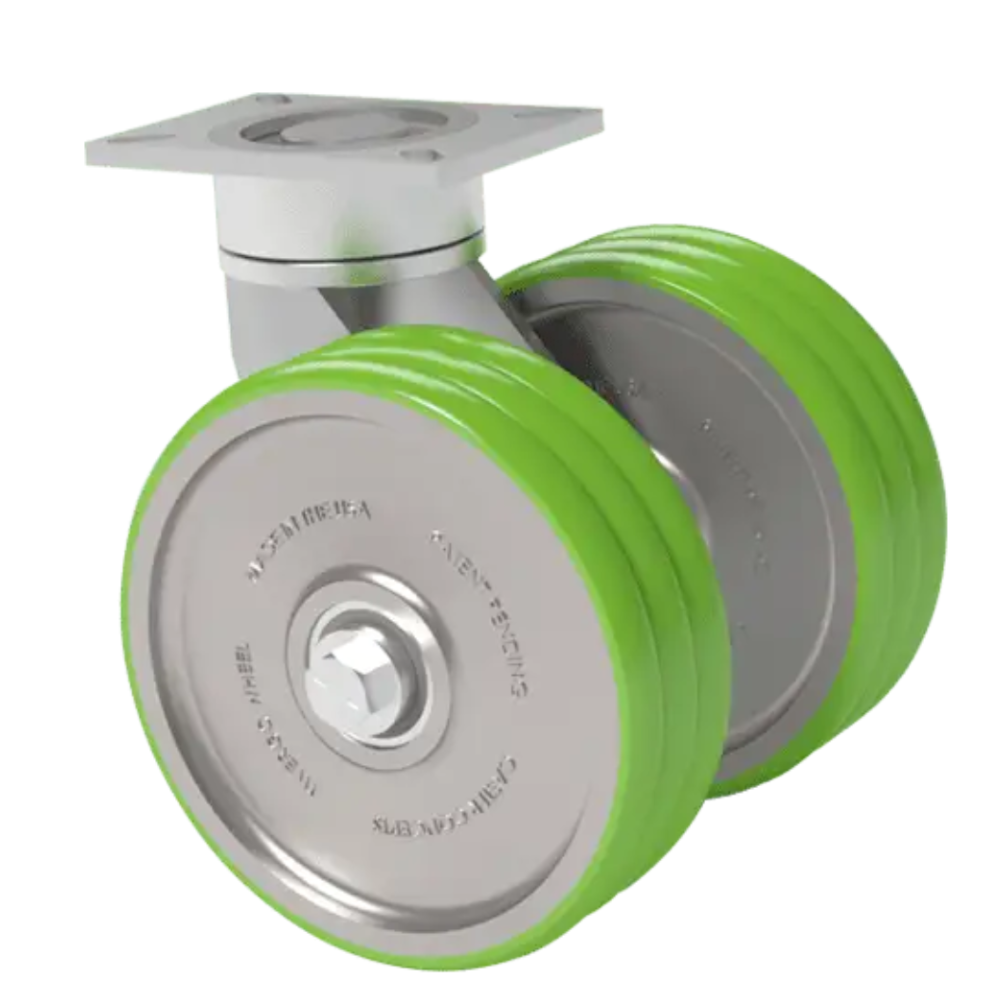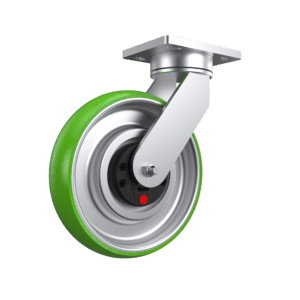

Most facility managers don’t realize it, but the industrial casters you’re using could be a major source of workplace noise, injuries, and unnecessary maintenance costs. The right caster wheels do more than serve as basic equipment components, they directly influence safety, operational efficiency, and floor maintenance costs. Polyurethane wheel casters demonstrate this by handling impressive loads while protecting floors from damage.
Noise reducing and shock absorbing industrial caster wheels designs deserve careful attention, particularly because workplace noise exposure regulations limit sound levels to 85-90 dB during 8-hour shifts. Ergonomic casters boost worker comfort and productivity through smoother movement that prevents muscle strains and other common workplace injuries. The durability of heavy duty industrial casters stands out, as forged steel versions deliver tensile strength of 64,000 psi and support loads up to 30,000 lbs.
This piece offers expert guidance to help you select the ideal ergonomic industrial casters that match your requirements. We provide practical recommendations that balance performance needs with facility maintenance, whether your priority lies in floor protection, noise reduction, or managing extreme weights.
Your choice of heavy duty caster material can make the difference between protecting your floors and causing expensive damage. Facility managers need to understand two key factors in floor-friendly casters: what the tread is made of and how hard the wheel is.
The tread material determines how an industrial caster interacts with your floor surface. Polyurethane is a top choice to protect floors. It excels at keeping metal shavings and other objects from being dragged across floors. This feature helps reduce the time you spend cleaning and repairing floors.
Metal wheels will damage hardwood floors and should never be used on them. Hard plastic casters put too much pressure on sensitive surfaces, so they won’t protect hardwood either.
The wheel’s hardness, measured on the durometer scale, affects how much wear it causes to floors. Polyurethane treads with a hardness range of 85 to 95A offer the best solution to prevent floor damage. This range gives you great debris resistance while keeping noise levels down.
The right hardness depends on your surface:
Softer wheels mold around obstacles instead of climbing over them, spreading out the force. Hard wheels create sharper force patterns, which leads to a rough ride and floor damage.

Noise and strain silently threaten workplace productivity and employee health. Specialized casters provide benefits that go way beyond the reach and influence of simple mobility.
Excessive workplace noise disrupts concentration and creates serious health risks. OSHA guidelines clearly show that an increase of just 5 decibels reduces an operator’s allowed exposure time by half. Noise-reducing casters have become essential equipment in industrial environments.
CasterShoX® technology offers remarkable sound dampening capabilities that reduce noise levels by up to 90% or 15 decibels. These specialized casters combine spring technology with polymer dampening to absorb vibrations at their source. A look at the mechanics shows the patented SHOX absorption unit after removing the wheel from the yoke this is the core component behind the impressive noise reduction.
Now, Ergo Tread CasterShox® takes this innovation a step further. By combining the advanced suspension system of CasterShoX® with a proprietary Ergo Tread polyurethane design, these casters are optimized for both sound reduction and ergonomic performance. They outperform traditional wheels in rollability, reducing push force by up to 60% and noise levels by an average of 15 decibels making them ideal for environments requiring low dBA ratings and quiet material transport.
Material selection plays a vital role in noise control. The best noise reducing caster wheels feature:
Moving heavy loads creates one of the most overlooked workplace injury risks. Yes, it is during pushing or pulling activities that your back faces the highest risk of debilitating injury. Well-designed ergonomic casters can reduce push/pull forces by up to 50% compared to traditional industrial designs.
TWERGO® caster technology stands out in ergonomic applications. The unique dumbbell design with independently rotating wheels minimizes friction. A patented face design with a parabolic wheel face achieves about 25% reduction in original push force right at the moment when injury risk peaks.
Ergo Tread CasterShox® compliments these efforts by offering a smooth, quiet, and ergonomically superior ride, especially in facilities where noise exposure and physical fatigue must be controlled without sacrificing load performance. These wheels can carry loads up to 3,000 lbs per caster, ideal for aerospace assembly carts, welding fixtures, and AGV systems.
Smart investment in caster wheels needs more than just looking at the price tag. Facility managers often focus too much on the upfront cost. This approach results in frequent replacements and gets pricey due to downtime.
Industrial casters’ real value comes from their Total Cost of Ownership (TCO) rather than the upfront price. High-quality caster wheels need less maintenance, reduce production interruptions, and help maximize production capacity. Premium options like CC Apex and CC Peak have shown a 25-50% reduction in push-pull efforts.
To assess value, think about these factors:
The most expensive caster might not be what you need. Starting with premium options and working down helps find the sweet spot between performance, reliability, and price.
Start by calculating your minimum load capacity with this formula: (Product Load + Cart Weight) ÷ (Number of Casters – 1) = Minimum Required Capacity per Caster. This careful approach helps deal with uneven floors where one caster wheel might not touch the ground.
Look past basic load ratings and check:
Comparison tools are a great way to evaluate caster wheels side-by-side. They help you find the right mix of ergonomics, floor protection, and durability factors that shape your facility’s long-term value.
The right heavy duty caster wheel for your needs depends on your specific environment. This piece explores how caster selection affects floor protection, noise levels, worker safety, and operational efficiency. The perfect industrial caster balances floor surface protection with performance needs.
Your true investment goes far beyond the original cost. Quality casters provide value through less maintenance, fewer workplace injuries, and longer floor life. The choice of materials plays a crucial role. Polyurethane options work best in most cases because they protect floors and handle heavy loads well.
Your selection process should focus equally on noise reduction and ergonomics. Specialized designs like CasterShoX and TWERGO technology will substantially reduce workplace noise and strain. This creates safer and more productive environments. Load ratings become critical for industrial uses. They help you pick reliable casters that maintain safety standards.
Base your final choice on total weight and usage patterns rather than minimum specs. This strategy helps select casters that protect floors, equipment, and workers while maximizing your investment. Casters might seem like a minor detail, but they without doubt make a huge difference in operations and maintenance.
Polyurethane and rubber are excellent choices for floor protection. Polyurethane offers superior debris rejection and high load capacity, while rubber provides excellent traction and shock absorption. Both materials are gentle on floors and help reduce wear and tear.
To reduce noise, opt for casters wheels with thermoplastic rubber or high-quality polyurethane treads, precision ball bearings, and shock-absorbing designs. Advanced technologies like CasterShoX can reduce noise levels by up to 90% or 15 decibels. Additionally, ensuring proper wheel hardness for your floor type can significantly decrease noise.
Look for casters designed to reduce push/pull forces, such as those with TWERGO technology. These casters can decrease initial push force by about 25%, lowering the risk of workplace injuries. Also, consider casters with vibration dampening properties to protect workers from continuous vibration exposure.
Calculate your minimum load capacity using this formula: (Product Load + Cart Weight) ÷ (Number of Casters – 1) = Minimum Required Capacity per Caster. Then, select casters with 25-30% more capacity than required for adequate protection. For heavy-duty applications, consider casters that can handle 2,000 to 4,999 lbs per caster or more.
While initial cost is a factor, it’s often more cost-effective in the long run to invest in higher-quality casters. Premium casters typically offer reduced maintenance costs, fewer production interruptions, and improved safety features. Consider the Total Cost of Ownership (TCO) rather than just the upfront price when making your decision.